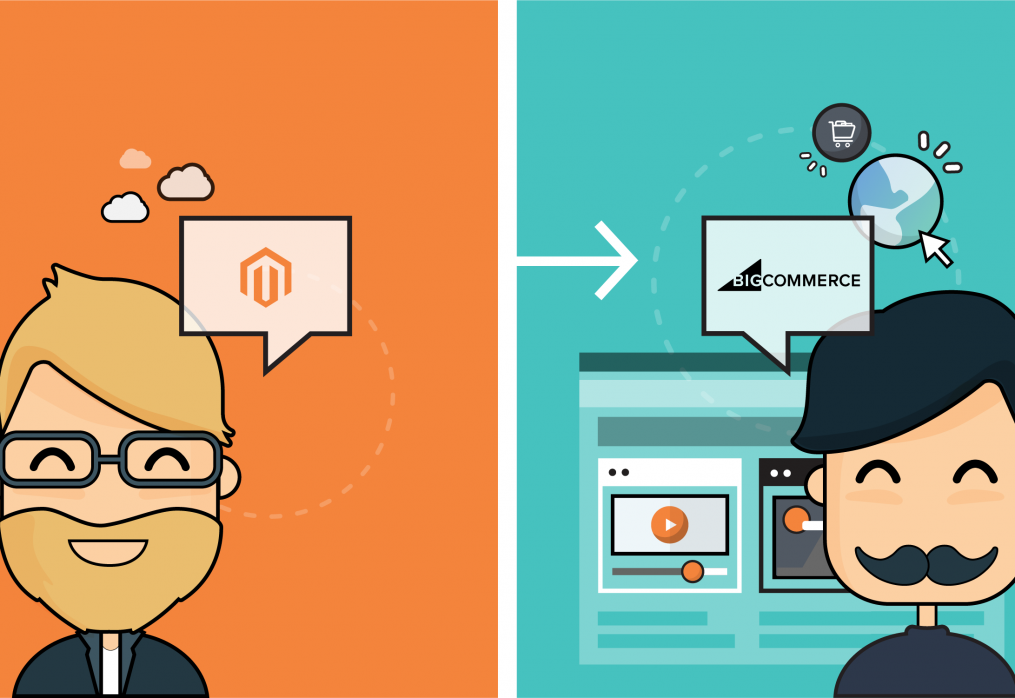July 03, 2020
It was 4 years ago when I first looked into SaaS eCommerce platforms like BigCommerce. In the past, it has always been about migrating the BigCommerce sites to Magento, for more robust feature availability and improved flexibility. However, in recent years I’m seeing the reverse of this trend. A reverse which makes migrating from a self-hosted platform like Magento to a cloud-based platform like BigCommerce.
It is not a surprise that working with BigCommerce ( and Moustache have been really in-depth lately) we find that BigCommerce has matured over the years. With the recent $64 million growth equity investment led by Goldman Sachs it’s expected to see an accelerated development roadmap to the platform. Together with the existing Enterprise level functionalities, this makes BigCommerce Enterprise a good candidate for platform upgrade for Magento Enterprise (v1.x) merchants.
Having migrated sites both ways, I’d like to share some recent experience working with both platforms and hopefully, it will provide some guidance for merchants who are considering the move.
Improvements you’ll see migrating to BigCommerce Enterprise;
Simplicity
You (especially your marketing team) will really enjoy the ease of product creation, promotional rule management, order management and content page creation. Promotional rules, in particular, have been the single biggest nightmare for marketers who work in the Magento backend. Magento is so cluttered that even seasoned pros make mistakes all the time. This has now been simplified and dramatically improved with BigCommerce.
Peace of mind
You don’t need to worry about hosting and securities, which is a BIG DEAL for larger retailers. With Magento (non-cloud versions) there is always the worry about the optimisation and maintenance of the hosting infrastructure, especially when you are required by your bank to have PCI compliance. This can be a major headache for merchants. Within Magento, merchants are responsible to keep their Magento site patched constantly for security reasons and when you fail to do so, your site will be hacked, it’s just a matter of time.
BigCommerce does take a headache away by providing a fully controlled PCI compliant infrastructure so you never need to worry about hosting and security anymore. What else would you want?
Ever improving
BigCommerce is constantly innovating and improving their platform ( and they have an extra $64million). You get new feature upgrades automatically as part of your subscription meaning you do not need to do it. Magento does improve and provide new releases, however, it is again the merchant’s responsibility to upgrade to the latest version, and due to the difficulty of upgrades for some major Magento releases, some merchants just choose not to upgrade which results in them having an out of date eCommerce platform.
This all sounds nice but there are a few things you’ll need to be aware of before migrating away from Open-Source platforms:
Multiple websites
As of today (May 1) BigCommerce still do not have native multiple website support like Magento does. Each BigCommerce website will be a standalone instance. You’ll find it a bit time consuming to keep all promotional rules, banners, stock levels etc. up to date throughout your sites when having more than 5 clone sites.
Large enterprise customers will use a PIM (Product Information Management) tool to keep all the product info in sync between all sites. Smaller businesses can use 3rd party apps to achieve the same thing, however, it is never as good as the native support provided by Magento. If multiple website support is key to your business make sure you spend the time to evaluate the solutions before making the switch to BigCommerce.
Dealing with Platform Limitations
Migrating from a self-hosted open source solution to a cloud-based SaaS solution requires a mindset shift also. Any business with decent development budget would’ve done major customisation to their Magento sites and there’s basically no limit to what they can achieve. When you can modify the source code, anything is achievable, so a lot of businesses are used to coming up with unique requirements and their development agency has the ability to implement those ideas. However, with BigCommerce as a SaaS e-commerce platform, you do not have access to the source code. You can modify the frontend look and feel then do further customisation through interactions with BigCommerce API, as a result, there will be limitations of the platform that you just can’t get around.
There will be certain things that are limited, eg there’s no out of the box grouped or bundle products in BigCommerce, if you have these setups in Magento you’ll have to use product options in BigCommerce and do a workaround on the website frontend to achieve the same look and feel.
To me, it is only inevitable for the trend of SaaS e-commerce solutions to take over. There are still limitations at this current stage so make sure you understand the limitations and have a plan to deal with it before you start making the switch. Making the decision is really only the first step, you’ll need to have a proper plan for the migration.
I’ll be sharing the things I’ve learned from the migration processes in a future article. Feel free to leave a comment if you have any questions or thoughts about e-commerce platforms.


